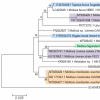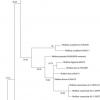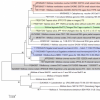
19-12-2025 10:10
Patrice TANCHAUDBonjour, récolte réalisée en milieu dunaire, a

18-12-2025 17:23
 Bruno Coué
Bruno Coué
Bonjour,je serais heureux d'avoir votre avis sur c

18-12-2025 21:17
Pol DebaenstThe identification took me to Byssonectria deformi

18-12-2025 18:07
Margot en Geert VullingsThese plumes were found on rotten wood.They strong

17-12-2025 18:35
 Michel Hairaud
Michel Hairaud
Bonjour à tous/Hi to everyone I am passing along

15-12-2025 15:48
 Danny Newman
Danny Newman
Melanospora cf. lagenaria on old, rotting, fallen

15-12-2025 15:54
 Johan Boonefaes
Johan Boonefaes
Unknown anamorph found on the ground in coastal sa

15-12-2025 21:11
 Hardware Tony
Hardware Tony
Small clavate hairs, negative croziers and IKI bb

15-12-2025 07:09
 Danny Newman
Danny Newman
indet. Rutstroemiaceae sp. on unk. fallen leavesMc
Est-ce que Mollisia faginea existe?
Louis DENY,
29-04-2025 09:13
Vosges du sud, ballon d'Alsace altitude 900/1 000 mètres. Terrain acide.
Sur cupule de hètre, avec Capitotricha fagiseda, Lachnum virgineum et Brunnipila fuscescens. Apothécie grise, marge et face externe plus claires. Subiculum présent. KOH ++
Spores légèrement courbées, de 14 juswu'à 17 µ de long, OCI = 2, petites guttules.
Asques à crochet, 60 µ. (sans doute plus, je n'ai pas mesuré d'asque vivant)
Tour colle parfaitement avec Mollisia faginea de la clé de Gminder.
Mon hésitation vient du fait que je ne trouve aucune autre mention de cette espèce, ni sur Ascofrance, ni sur Ascomycetes.org. Dans les fichiers de Zotto figure bien une Mollisia poussant sur cupule de Fagus ou de Castanea, mais sans nom.
Ma question : Mollisia faginea a-t-elle un autre nom ?
Merci de vos lumières
Hans-Otto Baral,
29-04-2025 09:27

Re : Est-ce que Mollisia faginea existe?
I know M. faginea only from the original description, according to my database, with spores 6-8 x 1 µm. Maybe Velenvsky's measurements are erroneous and too small, but probably not that difference.
I am unaware if Andreas reexamined the type.
Louis DENY,
29-04-2025 11:07
Re : Est-ce que Mollisia faginea existe?
Merci Zotto.
Having a look on "liste des hélotiales de Gerardmer" I found that:
Mollisia spec. sur cupule de Fagus. Trouvé souvent en juin en mélange avec les trois "Dasyscyphus" classiques sur cet habitat (Lachnum virgineum, Capitotricha fagiseda et Brunnipila fuscescens). Cette bonne espèce, signalée par A. Gminder dans sa clef inédite, mériterait un nom officiel.
It's then obviously an old story.
Having a look on "liste des hélotiales de Gerardmer" I found that:
Mollisia spec. sur cupule de Fagus. Trouvé souvent en juin en mélange avec les trois "Dasyscyphus" classiques sur cet habitat (Lachnum virgineum, Capitotricha fagiseda et Brunnipila fuscescens). Cette bonne espèce, signalée par A. Gminder dans sa clef inédite, mériterait un nom officiel.
It's then obviously an old story.
Hans-Otto Baral,
29-04-2025 11:52

Re : Est-ce que Mollisia faginea existe?
In Gminder's key (2008) I see M. faginea only mentioned for the type. No spore size.
In the Gérardmer report of your father there is no mention of spore size. Have you any notes where you could look up? Your spores are very long, but I am not sure if this is a substrate-specific fungus that you have collected.
Louis DENY,
29-04-2025 13:14
Re : Est-ce que Mollisia faginea existe?
I will try to have a look in his notes when I'm going there, normally next month.
Looking in MycoDB site, there is a translation of Gminder key for Mollisia, where I read this:
16.
a Sp. (9?)10-15 x 2,2-3,2 µm Q > 4 (en moyenne), apothécies + patelliformes, gris bleuâtre en général) Mollisia fusca
b Sp. semblables, mais volume huileux inférieur (1-2), cellules terminales de l'ectoexcipulum gris-brun, bien nettement différenciées. Au printemps sur les cupules et les très fines brindilles de Fagus, généralement avec Brunnipila fuscescens, Capitotricha fagiseda et Lachnum virgineum Mollisia "fagicola"
Spore dimension given here (10-15) are close to mine. Strange is that the name is now fagicola instead of faginea.
Thanks again for your help
Looking in MycoDB site, there is a translation of Gminder key for Mollisia, where I read this:
16.
a Sp. (9?)10-15 x 2,2-3,2 µm Q > 4 (en moyenne), apothécies + patelliformes, gris bleuâtre en général) Mollisia fusca
b Sp. semblables, mais volume huileux inférieur (1-2), cellules terminales de l'ectoexcipulum gris-brun, bien nettement différenciées. Au printemps sur les cupules et les très fines brindilles de Fagus, généralement avec Brunnipila fuscescens, Capitotricha fagiseda et Lachnum virgineum Mollisia "fagicola"
Spore dimension given here (10-15) are close to mine. Strange is that the name is now fagicola instead of faginea.
Thanks again for your help
Viktorie Halasu,
29-04-2025 15:05

Re : Est-ce que Mollisia faginea existe?
Hello,
"M. fagicola prov." was a provisorial name used by A. Gminder in his key and which, however, wouldn't be legitimate as there already is M. fagicola Noelli (described 1909 from beech leaves).
M. faginea Velen. - Gminder published his type study in 2012: https://czechmycology.org/_cmo/CM64201.pdf
He found significantly longer spores than the size given by Velenovsky, i.e. 7-12 × 1.8-2.5 um (in KOH).
However, M. Sandova (2023) revised all Mollisia specimens on beech cupules preserved in PRM and found that: 1) there are six different species and 2) the holotype of M. faginea contains also another species with shorter and narrower spores and KOH-negative reaction. Spore size of the latter fits better Velenovsky's description and therefore the name M. faginea needs a lectotypification. This article was published in Czech here: https://czechmycology.org/_ml/ML153.pdf#page=12
Viktorie
"M. fagicola prov." was a provisorial name used by A. Gminder in his key and which, however, wouldn't be legitimate as there already is M. fagicola Noelli (described 1909 from beech leaves).
M. faginea Velen. - Gminder published his type study in 2012: https://czechmycology.org/_cmo/CM64201.pdf
He found significantly longer spores than the size given by Velenovsky, i.e. 7-12 × 1.8-2.5 um (in KOH).
However, M. Sandova (2023) revised all Mollisia specimens on beech cupules preserved in PRM and found that: 1) there are six different species and 2) the holotype of M. faginea contains also another species with shorter and narrower spores and KOH-negative reaction. Spore size of the latter fits better Velenovsky's description and therefore the name M. faginea needs a lectotypification. This article was published in Czech here: https://czechmycology.org/_ml/ML153.pdf#page=12
Viktorie
Louis DENY,
29-04-2025 18:48
Re : Est-ce que Mollisia faginea existe?
Viktorie,
thank you for the clarification
Louis
thank you for the clarification
Louis
Hans-Otto Baral,
29-04-2025 21:19

Re : Est-ce que Mollisia faginea existe?
Great! The Gminder paper was not yet in my database, only in my files, and the detailed Sandova paper I was totally unaware. If someone has it as pdf (separated from the entire volume) I would appreciate that.
Zotto
Viktorie Halasu,
29-04-2025 21:52

Re : Est-ce que Mollisia faginea existe?
Hello Zotto,
here it is. Actual publication date is February 2023.
here it is. Actual publication date is February 2023.
Hans-Otto Baral,
29-04-2025 22:07

Re : Est-ce que Mollisia faginea existe?
Thanks!
Andreas Gminder,
04-05-2025 11:28

Re : Est-ce que Mollisia faginea existe?
Hello,
Mollisia faginea Velenovsky ss. my paper (= M. fageticola in my provisional key) is not too rare and always on Fagus cupules and rarely on vewry small twigs in the debris under Fagus. It is quite similar to Mollisia fusca by colour, KOH-reaction (although a bit weaker) and spore size (although with lower oil content), and also genetically (I have one ITS-Sequence) as far as I remember.
In my examination of the type I have not noticed another specimen, but have only examined one apothecium. So I'm also surprised by the results of the re-examination.
Probably it is best then to lectotypify the species with a collection with smaller spores fitting Velenovskys description and describing the species from Fagus cupules as new.
all the best,Andreas
Mollisia faginea Velenovsky ss. my paper (= M. fageticola in my provisional key) is not too rare and always on Fagus cupules and rarely on vewry small twigs in the debris under Fagus. It is quite similar to Mollisia fusca by colour, KOH-reaction (although a bit weaker) and spore size (although with lower oil content), and also genetically (I have one ITS-Sequence) as far as I remember.
In my examination of the type I have not noticed another specimen, but have only examined one apothecium. So I'm also surprised by the results of the re-examination.
Probably it is best then to lectotypify the species with a collection with smaller spores fitting Velenovskys description and describing the species from Fagus cupules as new.
all the best,Andreas
Hans-Otto Baral,
04-05-2025 17:48

Re : Est-ce que Mollisia faginea existe?
Hi Andreas
do you perhaps mean this ITS sequence:
Mollisia fagiseda Mo073 (Thüringen, Rhön, Fagus cupules)?
It is close to two Japanese sequences from Mollibase (one as T. fusca), but also to some M. cinereas.
I cannot see any system in this assemblage, either there is one variable species or many with more constant ITS.
Zotto
Andreas Gminder,
04-05-2025 18:53




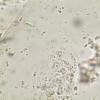
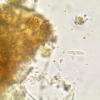
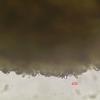
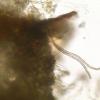
 Mollisia-revision-of-specimens-on-Fagus-fruits-in-PRM-Sandova-2023--0001.pdf
Mollisia-revision-of-specimens-on-Fagus-fruits-in-PRM-Sandova-2023--0001.pdf